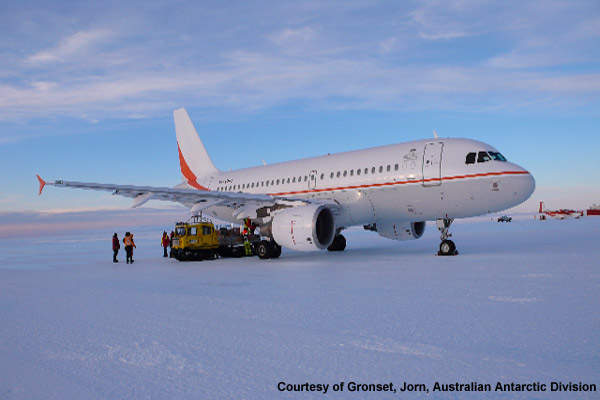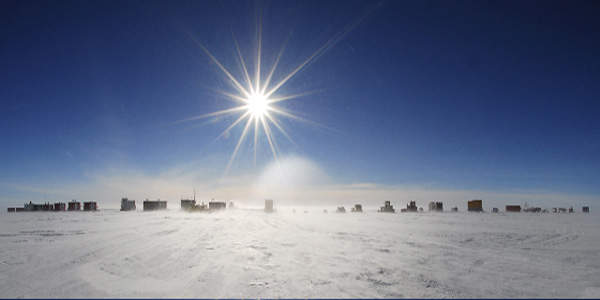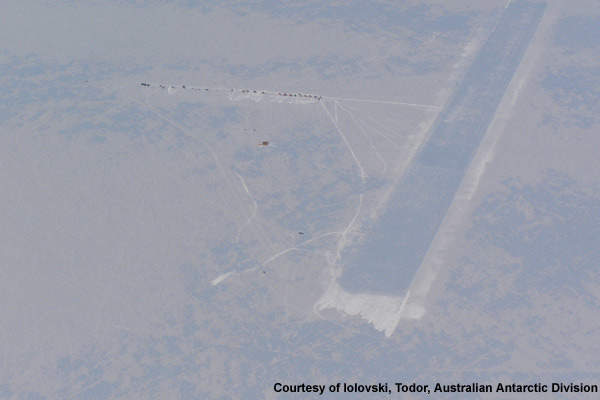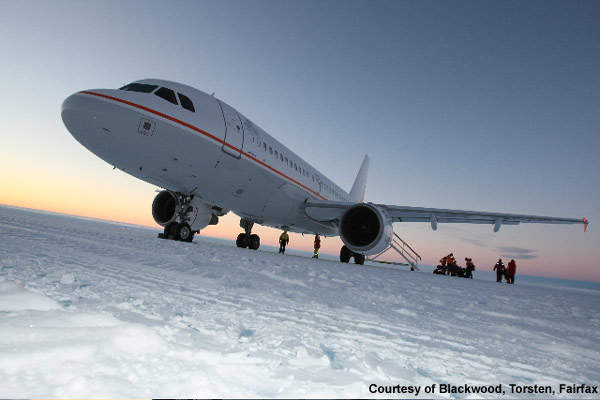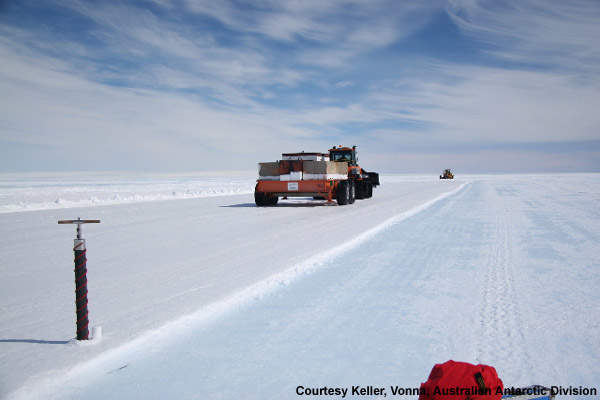As part of the Australian effort to continue research activities in the Australian Antarctic research station and to provide a service for other Antarctic expeditions the Australian Antarctic Division (AAD) has been instrumental in the development of the world’s first commercial air service to fly weekly from Hobart, Tasmania to the Wilkins runway in Antarctica.
The runway is around 65km (40 miles) – or three hours overland – from the Australian Antarctic research station of Casey. The service, which started in February 2008 (the first test flight was on 12 January 2008), is operated by Skytraders and uses an Airbus A319 jet which lands on a 2.5-mile glacial blue ice runway at Wilkins.
The runway was named after Sir George Hubert Wilkins, the Australian polar explorer, pilot, and geographer, who made the first Antarctic flight 79 years ago.
The runway has also become the centre of a shuttle network between Casey and other research stations on the continent (using ski planes).
Wilkins ice runway construction
The 2.5-mile long by 330ft-wide runway was constructed on the inland plateau of the Upper Peterson Glacier, which is around 2,300ft thick and moves about 40ft each year.
The construction work cost A$46.3m (US$42.2m) and began in 2005, taking three years to complete. The construction work was confined to a narrow timescale working from mid-November to mid-February as conditions in the area are not always ideal – some conditions experienced were temperatures as low as -32°F and wind speeds of 115mph but the average temperature was about -10°F.
The ice engineering required the runway to be cut from the glacial ice and levelled using laser technology (laser levelling was required by the Civil Aviation Safety Authority (CASA) of Australia). The foundation of the runway is natural glacial ice, rolled with proof rollers to ensure that the surface ice has suitable bearing strength and integrity to support the weight of the aircraft.
The surface was paved with compressed white snow as the glacial blue ice absorbs heat from the sun and melts to cause uneven pits. The white snow reflects light and heat and provides a better landing surface for aircraft. Precision approach path indicators were also installed on the side of the runway to provide a visual landing aid helping pilots judge their approach angle correctly.
The construction required the use of compactors (snow compaction required five passes with 24 hours between each pass), ploughs, and snow-throwers (shipped from Australia by boat over a period of five weeks). The operation of the runway requires a crew of eight to maintain the levels and the friction of the runway before each of the weekly landings.
The Airbus A319LR
The A319-115LR (long range) has a range of 7,500 miles, which means it can fly the round trip from Hobart to the Wilkins Runway and back without having to refuel (a distance of 4,965 miles). The flight in each direction takes about 4.5 hours but this depends upon the prevailing winds and weather.
The Airbus has twin engines and can transport up to 40 passengers and 6.5t of cargo on each trip. Upon landing at Wilkins runway the plane turnaround takes two to three hours on the ground before the return trip to Australia. The main purpose of the service is to transport scientists and other AAD staff to Antarctica for research purposes.
Facilities
The facilities at the air strip are fairly basic and are based around living units converted from shipping containers (Taylor Bros Builders). There are transit facilities, cold and warm storage, air field markers, emergency response facilities, navigation and meteorological stations, shelters for aircraft communications, medical services, living and emergency accommodation, workshop facilities, vehicle and sled parking as well as fuel storage and refuelling equipment.
The airstrip also keeps Schmidt Supra 4001and UTV430R Overassen snow blowers to remove snow fall from the runway and D7 bulldozers to remove accumulated berms from the side of the strip. There is also a rubber tracked tractor to tow planes.

